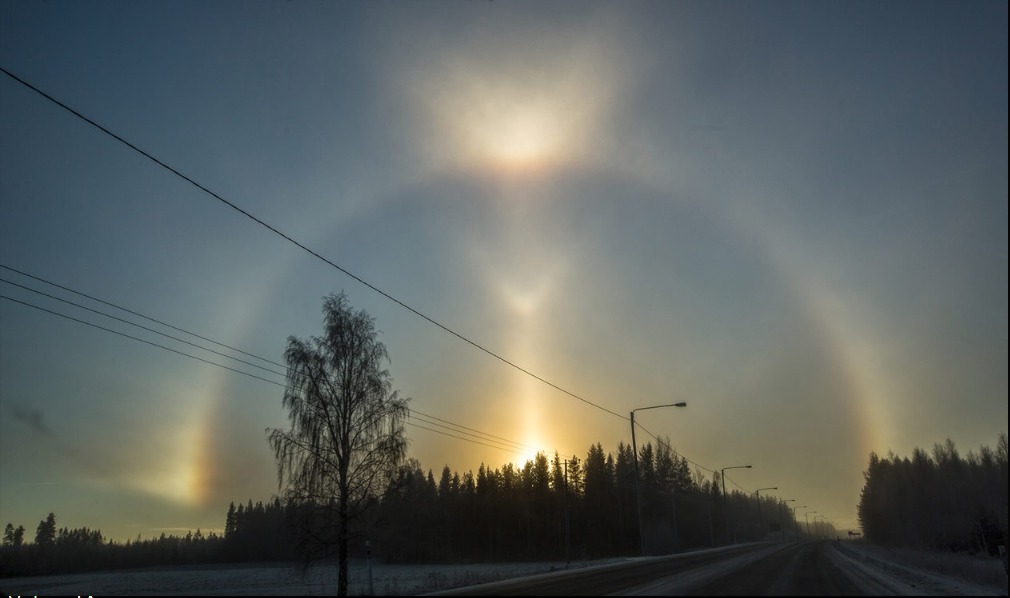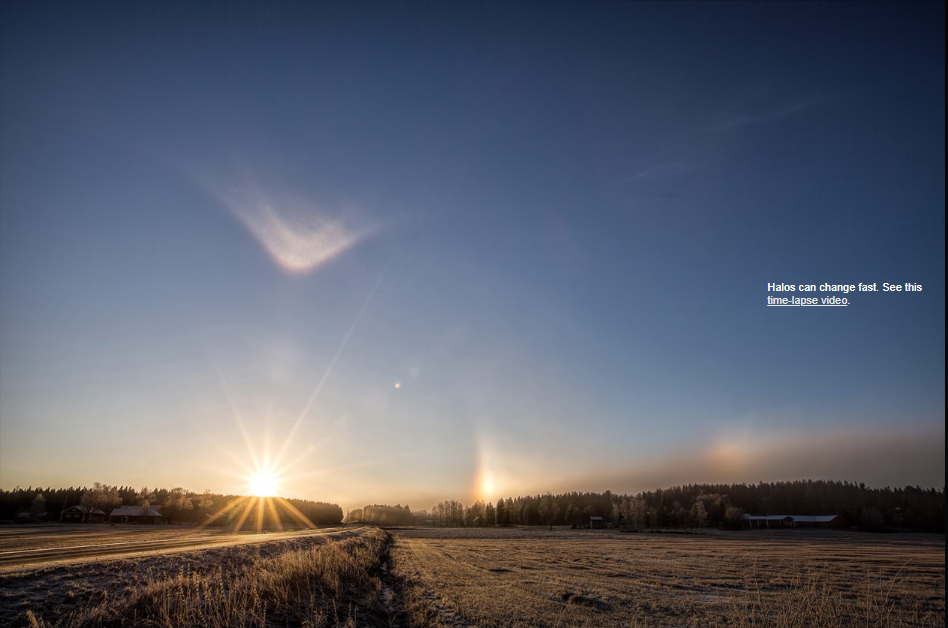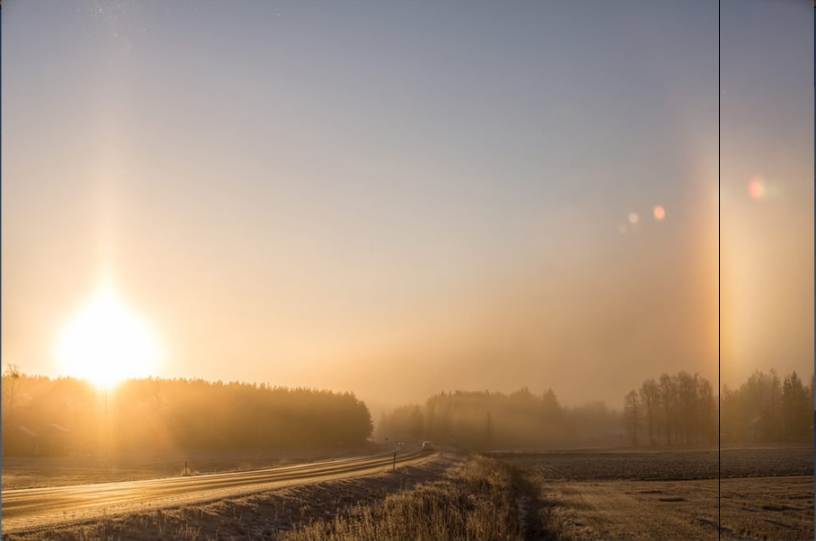Halos at Jalasjärvi, Finland- OPOD
Halos at Jalasjärvi, Finland: A Spectacular Display of Atmospheric Optics
In the enchanting skies of Jalasjärvi, Finland, a breathtaking display of ice halos was captured by photographer Pekka Lähteenmäki. These mesmerizing phenomena, known as halos, adorned the heavens with their intricate formations and vibrant colors. Among the remarkable halos witnessed in this display were three distinct "V" shaped arcs, known as sunvex arcs in halo terminology due to their convex shape in relation to the sun.
The lowest of these arcs is the enigmatic Moilanen arc. Its origins remain a mystery, as scientists are still uncertain about the crystal structure responsible for its formation. However, it is believed that these crystals possess two icy faces inclined at an angle of 34 degrees to each other. This unique configuration produces the striking appearance of the Moilanen arc in the sky.
Above the Moilanen arc lies the familiar upper tangent arc, a common sight in halo displays. It forms when sunlight refracts through ice crystals in the atmosphere, creating a distinct arc above the sun. This ethereal phenomenon has captivated skywatchers for centuries and continues to inspire awe with its graceful presence.
Adding to the rarity of this particular display, a Parry arc graced the skies above Jalasjärvi. The Parry arc is a relatively uncommon sight, only appearing approximately once a year on average. It was first recorded by William Edward Parry in 1820 during his Arctic expedition. The Parry arc forms when sunlight undergoes refraction and reflection within ice crystals, resulting in a luminous arc above the upper tangent arc.
The ever-changing nature of halos was evident in this captivating display. Time-lapse videos captured the mesmerizing transformation of these celestial phenomena, showcasing their dynamic and fleeting nature. The halos evolved and shifted, creating a captivating dance of light in the sky.
The formation of these rare halos can be attributed to near-optically perfect ice crystals that grew downwind of a nearby ski area. These crystals, shaped by the atmospheric conditions unique to the region, played a crucial role in the creation of the intricate halo formations witnessed in Jalasjärvi. The external reflection from Parry-oriented crystals resulted in the formation of helic arcs, which added to the visual spectacle.
Witnessing such a remarkable display of atmospheric optics serves as a reminder of the beauty and complexity present in our natural world. The skies above Jalasjärvi, Finland, provided a canvas for these captivating halos, showcasing the intricate interplay between light and ice crystals. Moments like these remind us of the wonders that can be found when we cast our gaze towards the heavens.
As we continue to explore and study atmospheric optics, each new discovery brings us closer to unraveling the mysteries of these captivating phenomena. The ethereal beauty of halos continues to inspire scientists and skywatchers alike, sparking curiosity and awe in those fortunate enough to witness their elusive presence. So keep your eyes on the sky, for you never know when the heavens will unveil their mesmerizing secrets once more.

V shaped Arcs ~ A spectacular ice halo display seen by Pekka L�hteenm�ki (Photography1, 2) at Jalasj�rvi, Finland. Above the low sun are three �V� shaped arcs � sunvex in halo terminology because they are convex to the sun. The lowest is the mysterious Moilanen arc. We are still unsure of what crystals make it but somewhere they must have two icy faces inclined 34 degrees to each other. Above that is the familiar upper tangent arc. Above the tangent arc is a second rarity, a Parry arc. Search the skies regularly and you might see one on average only once a year. Parry first recorded the arc in 1820 while icebound in the Arctic. All images ©Pekka L�hteenm�ki, shown with permission

Halos can change fast. See this time-lapse video.


Helic arcs formed by external reflection from Parry oriented crystals are evident in this shot. The Moilanen arc is particularly sharp and extensive.
Near optically perfect crystals that grew downwind of a nearby ski area likely formed these rare halos.
Note: this article has been automatically converted from the old site and may not appear as intended. You can find the original article here.
Reference Atmospheric Optics
If you use any of the definitions, information, or data presented on Atmospheric Optics, please copy the link or reference below to properly credit us as the reference source. Thank you!
-
<a href="https://atoptics.co.uk/blog/halos-at-jalasj-rvi-finland-opod/">Halos at Jalasjärvi, Finland- OPOD</a>
-
"Halos at Jalasjärvi, Finland- OPOD". Atmospheric Optics. Accessed on November 26, 2024. https://atoptics.co.uk/blog/halos-at-jalasj-rvi-finland-opod/.
-
"Halos at Jalasjärvi, Finland- OPOD". Atmospheric Optics, https://atoptics.co.uk/blog/halos-at-jalasj-rvi-finland-opod/. Accessed 26 November, 2024
-
Halos at Jalasjärvi, Finland- OPOD. Atmospheric Optics. Retrieved from https://atoptics.co.uk/blog/halos-at-jalasj-rvi-finland-opod/.